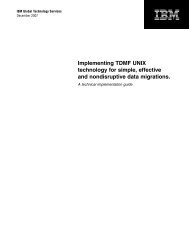A Primer for Healthcare Managers - IBM
A Primer for Healthcare Managers - IBM
A Primer for Healthcare Managers - IBM
Create successful ePaper yourself
Turn your PDF publications into a flip-book with our unique Google optimized e-Paper software.
ather than pushing <strong>for</strong> a particular solution. Total<br />
solution providers are preferred because of their<br />
integrated services.<br />
Contract negotiation<br />
Successful contract negotiation needs to adhere to<br />
the following guidelines. First, negotiations should<br />
focus on finding win-win solutions (Foster, 1996).<br />
This is consistent with the spirit of strategic partnership,<br />
which fosters flexibility and cushions against<br />
risks and uncertainty. Open and frequent communication<br />
of service needs and organizational concerns<br />
are a prerequisite <strong>for</strong> crafting a win-win solution.<br />
Outsourcing organizations and vendors need to<br />
identify the areas of complementary skills and<br />
resources. Organizations need to avoid a single<br />
focus on the lowest cost. This approach has proven<br />
to be problematic in pursuing long-term gain from<br />
outsourcing arrangements (Bendor-Samuel, 2002).<br />
Second, flexibility is a premium in service contracts.<br />
As a result, scalable and modular solutions are<br />
preferred (Goldman, 1998). Flexibility is important<br />
<strong>for</strong> coping with changing service needs. One<br />
approach is to include a benchmarking provision<br />
in the service contract. This provision usually<br />
requires the vendor to benchmark best practices<br />
and constantly improve its service quality by taking<br />
advantage of new technology.<br />
Third, the contract negotiated needs to have clauses<br />
that address the risk factors mentioned in the<br />
previous section. For example, the contract needs<br />
to include some safeguard <strong>for</strong> organizations whose<br />
primary concern is lack of control. Some additional<br />
control can be achieved by offering warranty and<br />
liability, terms <strong>for</strong> terminating a contract, and dispute<br />
resolution mechanisms to the client organization<br />
(Lee, 1996).<br />
Among all risk factors, security and business continuity<br />
need to be at the heart of a contract because<br />
they are often an organization’s primary concerns.<br />
In a service-level contract, organizations should<br />
require the statement of a security policy and<br />
practices that the vendor is going to take to maintain<br />
in<strong>for</strong>mation assurance. One method is to set up incident<br />
reporting requirements, where the vendor must<br />
report incidents of security breaches in the in<strong>for</strong>mation<br />
systems supporting IT services. In addition,<br />
to address the risk of un<strong>for</strong>eseen cost escalation,<br />
the service contract should also include pricing and<br />
payment terms <strong>for</strong> services (Lee, 1996).<br />
Lastly, a properly drafted contract also needs to<br />
address transition and operational relationships,<br />
and the transfer of both assets and personnel must<br />
be specified. The operational relationship envisioned<br />
in Phase 2 needs to be part of the service-level<br />
agreement as well. Both parties should agree on<br />
a <strong>for</strong>mal management structure that oversees the<br />
transition and contract implementation.<br />
In this phase, the organization has several ways of<br />
better managing the process. One is to continue<br />
utilizing a learning network to learn about innovative<br />
ways to address changing service needs and security<br />
issues throughout the entire phase. <strong>Managers</strong><br />
need to budget time and resources <strong>for</strong> selecting<br />
vendors and subsequently negotiating items in the<br />
service-level agreement. <strong>Managers</strong> should also<br />
require a demonstration of key capabilities such as<br />
business recovery (continuity) and security measures.<br />
A site visit should also be required be<strong>for</strong>e the client<br />
organization signs the agreement (Embleton and<br />
Wright, 1998).<br />
Phase 3: Best Practices<br />
• Select vendors that can best meet the sourcing<br />
needs of the organization. <strong>Managers</strong> need to<br />
examine the alignment of business goals of the<br />
parties involved, the complementary nature of<br />
skill sets, the reliability of the vendor, and IT<br />
security.<br />
• Choose system integrators when available <strong>for</strong><br />
minimizing risks. System integrators have<br />
the advantage that they are flexible and also<br />
cushion against market instability.<br />
• Negotiate a contract in the spirit of building<br />
a long-term partnership. It is better to seek a<br />
win-win agreement by engaging in open and<br />
frequent communication.<br />
• Produce a service-level contract that addresses<br />
risk factors and clearly delineates operational<br />
relationships. The service contract needs<br />
to be specific and flexible, and operational<br />
relationships should be an integral part of the<br />
agreement.<br />
<strong>IBM</strong> Center <strong>for</strong> <strong>Healthcare</strong> Management 17

















